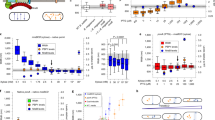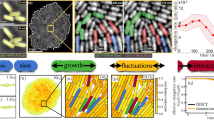Abstract
The shapes of most bacteria are imparted by the structures of their peptidoglycan cell walls, which are determined by many dynamic processes that can be described on various length scales ranging from short-range glycan insertions to cellular-scale elasticity1–11. Understanding the mechanisms that maintain stable, rod-like morphologies in certain bacteria has proved to be challenging due to an incomplete understanding of the feedback between growth and the elastic and geometric properties of the cell wall3,4,12–14. Here, we probe the effects of mechanical strain on cell shape by modelling the mechanical strains caused by bending and differential growth of the cell wall. We show that the spatial coupling of growth to regions of high mechanical strain can explain the plastic response of cells to bending4 and quantitatively predict the rate at which bent cells straighten. By growing filamentous Escherichia coli cells in doughnut-shaped microchambers, we find that the cells recovered their straight, native rod-shaped morphologies when released from captivity at a rate consistent with the theoretical prediction. We then measure the localization of MreB, an actin homologue crucial to cell wall synthesis, inside confinement and during the straightening process, and find that it cannot explain the plastic response to bending or the observed straightening rate. Our results implicate mechanical strain sensing, implemented by components of the elongasome yet to be fully characterized, as an important component of robust shape regulation in E. coli.
This is a preview of subscription content, access via your institution
Access options
Access Nature and 54 other Nature Portfolio journals
Get Nature+, our best-value online-access subscription
$29.99 / 30 days
cancel any time
Subscribe to this journal
Receive 12 digital issues and online access to articles
$119.00 per year
only $9.92 per issue
Buy this article
- Purchase on Springer Link
- Instant access to full article PDF
Prices may be subject to local taxes which are calculated during checkout




Similar content being viewed by others
References
Cabeen, M. T. & Jacobs-Wagner, C. Bacterial cell shape. Nat. Rev. Microbiol. 3, 601–610 (2005).
Young, K. D. The selective value of bacterial shape. Microbiol. Mol. Biol. Rev. 70, 660–703 (2006).
Amir, A. & van Teeffelen, S. Getting into shape: how do rod-like bacteria control their geometry? Syst. Synth. Biol. 8, 227–235 (2014).
Amir, A., Babaeipour, F., McIntosh, D. B., Nelson, D. R. & Jun, S. Bending forces plastically deform growing bacterial cell walls. Proc. Natl Acad. Sci. USA 111, 5778–5783 (2014).
Garner, E. C. et al. Coupled, circumferential motions of the cell wall synthesis machinery and MreB filaments in B. subtilis. Science 333, 222–225 (2011).
Domínguez-Escobar, J. et al. Processive movement of MreB-associated cell wall biosynthetic complexes in bacteria. Science 333, 225–228 (2011).
Lee, T. K. et al. A dynamically assembled cell wall synthesis machinery buffers cell growth. Proc. Natl Acad. Sci. USA 111, 4554–4559 (2014).
Paradis-Bleau, C. et al. Lipoprotein cofactors located in the outer membrane activate bacterial cell wall polymerases. Cell 143, 1110–1120 (2010).
Typas, A. et al. Regulation of peptidoglycan synthesis by outer-membrane proteins. Cell 143, 1097–1109 (2010).
Reshes, G., Vanounou, S., Fishov, I. & Feingold, M. Cell shape dynamics in Escherichia coli. Biophys. J. 94, 251–264 (2008).
Bartlett, T. M. et al. A periplasmic polymer curves Vibrio cholerae and promotes pathogenesis. Cell 168, 172–185 (2017).
Ursell, T. S. et al. Rod-like bacterial shape is maintained by feedback between cell curvature and cytoskeletal localization. Proc. Natl Acad. Sci. USA 111, 1025–1034 (2014).
Amir, A. & Nelson, D. R. Dislocation-mediated growth of bacterial cell walls. Proc. Natl Acad. Sci. USA 109, 9833–9838 (2012).
Si, F., Li, B. & Sun, S. X. Bacterial growth and shape regulation by external compression. Sci. Rep. 5, 11367 (2015).
Meeske, A. J. et al. SEDS proteins are a widespread family of bacterial cell wall polymerases. Nature 537, 634–638 (2016).
Cho, H. et al. Bacterial cell wall biogenesis is mediated by SEDS and PBP polymerase families functioning semi-autonomously. Nat. Microbiol. 1, 16172 (2016).
Nguyen, L. T., Gumbart, J. C., Beeby, M. & Jensen, G. J. Coarse-grained simulations of bacterial cell wall growth reveal that local coordination alone can be sufficient to maintain rod shape. Proc. Natl Acad. Sci. USA 112, E3689–E3698 (2015).
Renner, L. D., Eswaramoorthy, P., Ramamurthi, K. S. & Weibel, D. B. Studying biomolecule localization by engineering bacterial cell wall curvature. PLoS ONE 8, e84143 (2013).
Caspi, Y. Deformation of filamentous Escherichia coli cells in a microfluidic device: a new technique to study cell mechanics. PLoS ONE 9, e83775 (2014).
Takeuchi, S., DiLuzio, W. R., Weibel, D. B. & Whitesides, G. M. Controlling the shape of filamentous cells of Escherichia coli. Nano Lett. 5, 1819–1823 (2005).
Mannik, J., Driessen, R., Galajda, P., Keymer, J. E. & Dekker, C. Bacterial growth and motility in sub-micron constrictions. Proc. Natl Acad. Sci. USA 106, 14861–14866 (2009).
Cabeen, M. T. et al. Bacterial cell curvature through mechanical control of growth. EMBO J. 28, 1208–1219 (2009).
Sliusarenko, O., Cabeen, M. T., Wolgemuth, C. W., Jacobs-Wagner, C. & Emonet, T. Processivity of peptidoglycan synthesis provides a built-in mechanism for the robustness of straight-rod cell morphology. Proc. Natl Acad. Sci. USA 107, 10086–10091 (2010).
Mukhopadhyay, R. & Wingreen, N. S. Curvature and shape determination of growing bacteria. Phys. Rev. E 80, 062901 (2009).
Rojas, E., Theriot, J. A. & Huang, K. C. Response of Escherichia coli growth rate to osmotic shock. Proc. Natl Acad. Sci. USA 111, 7807–7812 (2014).
Wang, S., Furchtgott, L., Huang, K. C. & Shaevitz, J. W. Helical insertion of peptidoglycan produces chiral ordering of the bacterial cell wall. Proc. Natl Acad. Sci. USA 109, 595–604 (2012).
van Teeffelen, S. et al. The bacterial actin MreB rotates, and rotation depends on cell-wall assembly. Proc. Natl Acad. Sci. USA 108, 15822–15827 (2011).
Harris, L. K., Dye, N. A. & Theriot, J. A. A Caulobacter MreB mutant with irregular cell shape exhibits compensatory widening to maintain a preferred surface area to volume ratio. Mol. Microbiol. 94, 988–1005 (2014).
Kim, S. Y., Gitai, Z., Kinkhabwala, A., Shapiro, L. & Moerner, W. E. Single molecules of the bacterial actin MreN undergo directed treadmilling motion in Caulobacter crescentus. Proc. Natl Acad. Sci. USA 103, 10929–10934 (2006).
Tuson, H. H. et al. Measuring the stiffness of bacterial cells from growth rates in hydrogels of tunable elasticity. Mol. Microbiol. 85, 874–891 (2012).
Stewart, E. J., Madden, R., Paul, G. & Taddei, F. Aging and death in an organism that reproduces by morphologically symmetric division. PLoS Biol. 3, e45 (2005).
Ouzounov, N. et al. MreB orientation correlates with cell diameter in Escherichia coli. Biophys. J. 111, 1035–1043 (2016).
Paradis-Bleau, C. et al. Lipoprotein cofactors located in the outer membrane activate bacterial cell wall polymerases. Cell 143, 1110–1120 (2010).
Egan, A. J. F. et al. Outer-membrane lipoprotein LpoB spans the periplasm to stimulate the peptidoglycan synthase PBP1B. Proc. Natl Acad. Sci. USA 111, 8197–8202 (2014).
Lee, T. K., Meng, K., Shi, H. & Huang, K. C. Single-molecule imaging reveals modulation of cell wall synthesis dynamics in live bacterial cells. Nat. Commun. 7, 13170 (2016).
Efrati, E., Sharon, E. & Kupferman, R. The metric description of elasticity in residually stressed soft materials. Soft Matter 9, 8187–8197 (2013).
Santangelo, C. D. Buckling thin disks and ribbons with non-Euclidean metrics. EPL 86, 34003 (2009).
Weibel, D. B., Diluzio, W. R. & Whitesides, G. M. Microfabrication meets microbiology. Nat. Rev. Microbiol. 5, 209–218 (2007).
Renner, L. D. & Weibel, D. B. Cardiolipin microdomains localize to negatively curved regions of Escherichia coli membranes. Proc. Natl Acad. Sci. USA 108, 6264–6269 (2011).
Xia, Y. & Whitesides, G. M. Soft lithography. Angew. Chem. Int. Ed. 37, 550–575 (1998).
Huang, J., Cao, C. & Lutkenhaus, J. Interaction between FtsZ and inhibitors of cell division. J. Bacteriol. 178, 5080–5085 (1996).
Huisman, O., D'Ari, R. & Gottesman, S. Cell-division control in Escherichia coli: specific induction of the SOS function SfiA protein is sufficient to block septation. Proc. Natl Acad. Sci. USA 81, 4490–4494 (1984).
Bertani, G. Studies on lysogenesis. I. The mode of phage liberation by lysogenic Escherichia coli. J. Bacteriol. 62, 293–300 (1951).
Bertani, G. Lysogeny at mid-twentieth century: P1, P2, and other experimental systems. J. Bacteriol. 186, 595–600 (2004).
Miller, J. H. Experiments in Molecular Genetics (Cold Spring Harbor, 1972).
Sliusarenko, O., Heinritz, J., Emonet, T. & Jacobs-Wagner, C. High-throughput, subpixel precision analysis of bacterial morphogenesis and intracellular spatio-temporal dynamics. Mol. Microbiol. 80, 612–627 (2011).
Acknowledgements
F.W. was supported by the National Science Foundation Graduate Research Fellowship under grant no. DGE1144152. L.D.R., S.v.T. and A.A. were supported by the Volkswagen Foundation. G.O. and S.v.T. were supported by funds from the European Research Council (ERC-2015-STG RCSB 679980), the LabEx IBEID (Integrative Biology of Emerging Infectious Diseases) programme, the Mairie de Paris ‘Emergence(s)’ programme, and the ANR ‘Investissement d'Avenir Programme’ (10-LABX-62-IBEID) to S.v.T. J.P. acknowledges funding by a Delta ITP Zwaartekracht grant. A.A. was supported by the Alfred P. Sloan Foundation. The authors thank J. Hutchinson for discussions on shell theory, J. Hutchinson, E.C. Garner and C. Wivagg for comments on the manuscript, L. Mahadevan and C. Wivagg for discussions on the model, K. Bertoldi and J. Liu for help with simulation software, E. Oldewurtel and E. Brambilla for help with microscopy and N. Ouzounov for providing the MreB-msfGFP strain.
Author information
Authors and Affiliations
Contributions
F.W. and A.A. developed the model of straightening. F.W. and J.P. performed simulations. L.D.R., G.Ö., D.B.W., S.v.T. and A.A. designed the experiments. L.D.R. and G.Ö. performed the experiments. F.W., L.D.R. and G.Ö. analysed the data. F.W. and G.Ö. wrote cell-tracking software. F.W., L.D.R., G.Ö., S.v.T. and A.A. wrote the paper.
Corresponding authors
Ethics declarations
Competing interests
The authors declare no competing financial interests.
Supplementary information
Supplementary Information
Supplementary Notes 1 and 2, Supplementary Discussion, Supplementary Methods, Supplementary References, Supplementary Tables 1 and 2, Supplementary Figures 1–11. (PDF 14721 kb)
Supplementary Video 1
Straightening dynamics of single E. coli cells. Supplementary Videos 1–10 show individual, filamentous E. coli cells recovering their native rod shapes as they grow after release from toroidal microchambers. The time between frames is 2 minutes, the time lapses cover a period of around 40 minutes, and the field of view is approximately 40 μm wide. (MOV 73 kb)
Supplementary Video 2
Straightening dynamics of single E. coli cells. (MOV 58 kb)
Supplementary Video 3
Straightening dynamics of single E. coli cells. (MOV 63 kb)
Supplementary Video 4
Straightening dynamics of single E. coli cells. (MOV 34 kb)
Supplementary Video 5
Straightening dynamics of single E. coli cells. (MOV 123 kb)
Supplementary Video 6
Straightening dynamics of single E. coli cells. (MOV 92 kb)
Supplementary Video 7
Straightening dynamics of single E. coli cells. (MOV 52 kb)
Supplementary Video 8
Straightening dynamics of single E. coli cells. (MOV 94 kb)
Supplementary Video 9
Straightening dynamics of single E. coli cells. (MOV 72 kb)
Supplementary Video 10
Straightening dynamics of single E. coli cells. (MOV 20 kb)
Supplementary Video 11
Numerical simulation of the growth process. Numerical simulations in (1) the case of zero processivity; (2) the case of infinite processivity; and (3) the case of a self-consistent areal strain coupling that results in a constant differential growth in phase 1 and straightening in phase 2. The simulation methodology is detailed in the Supplementary Methods. (MP4 5860 kb)
Rights and permissions
About this article
Cite this article
Wong, F., Renner, L., Özbaykal, G. et al. Mechanical strain sensing implicated in cell shape recovery in Escherichia coli. Nat Microbiol 2, 17115 (2017). https://doi.org/10.1038/nmicrobiol.2017.115
Received:
Accepted:
Published:
DOI: https://doi.org/10.1038/nmicrobiol.2017.115



